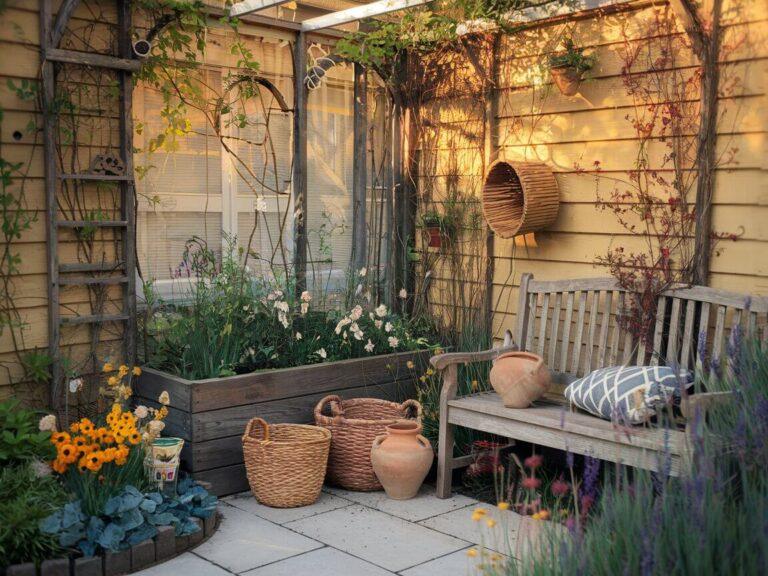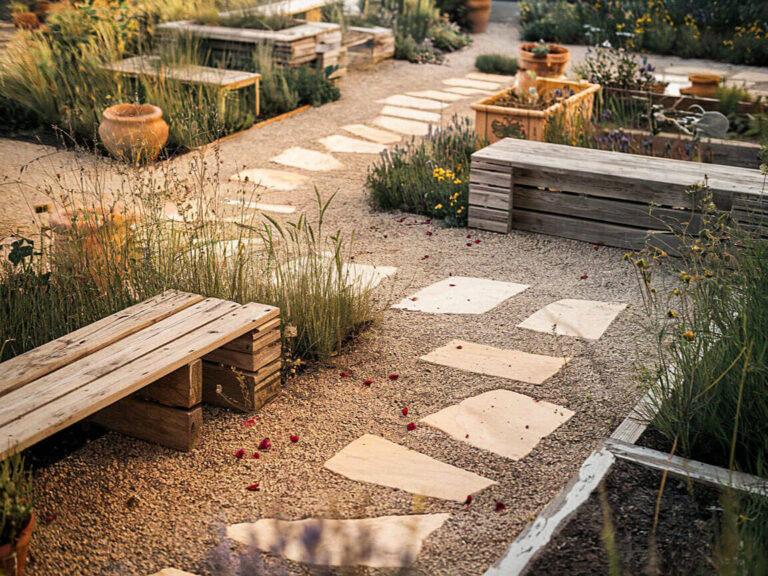Create Your Own Andalusian-Inspired Sun Garden
This website contains affiliate links. As an Amazon affiliate, I earn from qualifying purchases.
Gardens in Andalusia possess a timeless and soul-stirring quality. These Spanish sanctuaries, bathed in golden light and the fragrance of orange blossoms, feature water with glassy surfaces, combining sun and cool shade, nature enhanced by an artifice that lends it its own charm: stone everywhere.
The perfect city weather, coupled with this perfect balance between town and country, is evident in its savage beauty.
In this guide, we’ll learn a few tricks from The Famed Gardens of Seville and Cordoba. Since we strongly believe that establishing such a style need not be difficult, we can tailor or combine feature elements into any area at all.
You will learn how to blend plants, fountains, terracotta, and tranquil spaces into a Mediterranean garden that feels like an everyday escape.
What Defines an Andalusian Garden?
On the harmony of water and stone, people and nature, shade and sunlight, an Andalusian garden is constructed.
Drawing inspiration from the palace gardens of the Alhambra in Granada and the Alcazar of Seville, gardens in traditional Southern Spain style eschew sensuous delight, instead aiming for a sense of equilibrium.
A dry Mediterranean climate completes the picture. Unlike meticulously tended gardens, Andalusian gardens possess a subtle beauty.
The layout is often symmetrical, with pathways leading to central features, such as fountains and ponds, encircled by lush plantings. The aim is to create a tranquil space that is timeless yet bursting with the spirit of Andalucia, which surrounds you.
How Do Spanish Gardens Balance Water and Sun?
Water serves as the heart of an Andalusian courtyard garden, as they often exist only for a couple of years before drying out due to poor maintenance or unfavorable conditions.
Certainly, in 1950, such a series could have been built. Sea, intent on returning the green that people had taken from its waters, graduates would be loath to echo her despair and her futility.
However, by reconstructing the ancient gardens at a vast expense and with obvious pain, they finally saw their plans bear fruit.
Fountains, pools, or even little rivulets of running water serve as reminders that these gardens were begun centuries ago with the help of the Moors.
A simple fountain or a small water lily pond can turn your garden into a peaceful oasis. The sound of water adds movement and life throughout the garden, while the reflection of light results in a sense of how deep or still everything is going on around us for miles on end us.
Even in smaller outdoor areas, a wall-mounted fountain or bird bath can evoke the atmosphere of Andalusia’s most famous gardens.
What Plants Define the Spirit of Andalusia?
With its rustic stone walls and plants that seem to have grown and flourished there since time immemorial, the decor is full of the melancholy but powerful reza of a bygone era in southern Spain.
All the features of an Andalusian garden, blossoming in full swing, abound, with the most outstanding perhaps being the seemingly infinite stretch of bougainvillea-laden branches.
Lush fruit trees, integrated with tall green hedges that shelter you from the searing sun, provide a cool and refreshing respite. Next, tall cypress trees and garden sofas form an S-shaped entranceway to the central patio area.
This space also has a raised rectangular pool fed from below by spring water leaking out from underneath a road running alongside the eastern wall of the house; more intimate areas are concealed around corners or behind screens of yew and bamboo.
Finally, the lush foliage of the olive tree makes for an enchanting garden that cannot help but beckon. Its slender branches extend from the trunk to the ground, creating a sense of overwhelming prosperity.
Its uneven and dark gray leaves furnish both depth and structure to the collection of conifers that form another means of ensuring shade from those Indian summer mornings.
In the distance, lemon trees, illuminated by sunlight, cast a brightness upon rows of pink, purple, and white flowers.
With three mattresses lined up south to north, they are shielded by cypress trees to the east, swaying briskly above these young plants, which were just planted last spring.
And all around, rows of lushly flowering bougainvillea release fresh flowers that brighten the day. They brighten the gardens of Andalusia, to boot, with a charming air.
And here is an extraordinary collection of scented herbs, such as rosemary and delightful lavender, carefully interwoven among the sun-loving perennials and succulents that thrive in this sun-drenched garden paradise.
Not only do these hardy plants flourish under the warm, dry conditions typical of Andalusia’s climate in general, but they also make a vital contribution to the garden’s smell and simple elegance, providing a sensory experience that is as irresistible as the scent of flowers.
When you’re drawing up your own garden oasis, it’s important to choose resilient plants that thrive not only under warm, arid conditions but also in well-drained garden soil that ensures your outdoor space is as rich as the gardens of Andalusia.
How to Incorporate Moorish Influence into Garden Design
The Moorish influence runs deep in Andalusian garden aesthetics. Symmetry, geometry, and water play central roles in this style, seen in the courtyards of the Alhambra and the gardens of Seville. Tiles, arches, and intricate detailing turn simple garden elements into works of art.
Try adding terracotta tiles or patterned mosaics to your patio flooring or around fountains. Decorative screens or wrought iron gates can frame entrances, while a row of ceramic planters ties the look together.
This blend of texture, color, and craftsmanship captures the essence of Andalusian design principles while keeping your outdoor space both functional and visually appealing.
What Makes Andalusian Patios So Inviting?
In the enchanting region of Andalusia, the patio is where outdoor living thrives.
The glowing, whitewashed walls that surround a patio will keep you cool in oppressive summer heat.
Thoughtfully designed for both major lounging and noisy celebration, it is a cool, exquisite blend of terracotta and marble floors, vines of growing plants.
You can also add comfortable, shaded seating areas that lead to a scene so perfect it is hard to capture in words, making this place the ideal setting for lazy summer afternoons and lovely evening parties.
Embrace the magic of mixing textures, imagining terracotta tiles for the warmth, and broken chairs woven with wicker or quilted linen cushions.
This may well bring about a small change in mood, but they don’t change anything too fancy; all three “complete” each other.
That’s charm, that’s what makes it live. Mixing materials from all angles to give the Andalusian-style patio every chance of evolution is a lasting solution for your establishment.
Mixing a few citrus trees with fruit to enjoy and flowers for perfume into pots, or adding a cluster of bright, flowering bougainvillea as color accents, will make your yard that much more appealing.
This takes your patio design to another level. With this kind of planning, the patio becomes an organic extension of the garden, not just ideal for alfresco living but also a tranquil place to think in the early morning, as the natural world gently envelops you.
How Do the Gardens of Seville and Cordoba Inspire Modern Design?
The magnificent Real Alcázar in Seville features many enchanting gardens, and these classical masterpieces, filled with water, stone, and perfectly achieved symmetrical shapes, are indeed the quintessence.
On the other hand, at Córdoba, the famous patios add to their patina not only bright tiles festooned with flowers that cascade from ceramic pots, but also two examples that perfectly illustrate how small spaces can be made into lush retreats to suit both soul and eye in any shape or form.
In these two outstanding cities, one can see the strongest expression of the concept that a garden is not simply an outdoor space, but rather it represents a way of life, a certain attunement with nature, and a refined taste.
And as such, anyone who lives in a cramped apartment in possession of its own charming balcony or an elegant manor house with an attractive central courtyard will come to feel that Andalusian design is more than wonderfully clever.
With just a few well-chosen cypress trees, the soft tinkle of running water, and a selection of appropriate cooker-plants, one can turn even the smallest location into a flourishing extension of the enchanting gardens of Andalusia.
In that place, they offer an unparalleled feeling of peace in harmony with nature.
How to Use Terracotta and Hard Landscaping for Mediterranean Charm
The magnificent Real Alcázar in Seville features many enchanting gardens, and these classical masterpieces, filled with water, stone, and perfectly achieved symmetrical shapes, are indeed the quintessence.
On the other hand, at Córdoba, the famous patios add to their patina not only bright tiles festooned with flowers that cascade from ceramic pots, but also two examples that perfectly illustrate how small spaces can be made into lush retreats to suit both soul and eye in any shape or form.
In these two outstanding cities, one can see the strongest expression of the concept that a garden is not simply an outdoor space, but rather it represents a way of life, a certain attunement with nature, and a refined taste.
And as such, anyone who lives in a cramped apartment in possession of its own charming balcony or an elegant manor house with an attractive central courtyard will come to feel that Andalusian design is more than wonderfully clever.
It shows ample proof that good taste does not always go hand in hand with payback or apparent increase, but is a product placed directly by human intent and foresight.
With just a few well-chosen cypress trees, the soft tinkle of running water, and a selection of appropriate cooker-plants, one can turn even the smallest location into a flourishing extension of the enchanting gardens of Andalusia.
In that place, they offer an unparalleled feeling of peace in harmony with nature.
How to Design Seating Areas and Outdoor Dining Spaces
In southern Spain, people consider outdoor dining a form of pleasure in life. Many an Andalusian garden features an Alhambra-style patio with seating, offering cozy spots amidst the blooms of planted vegetation and invariably a fountain nearby.
The aim is to make outdoor spaces feel like an indoor, completely comfortable, and adapted place of peace and rest. Using wrought iron furniture with matching cushions, or hand-painted pottery, to top a set table is a realistic option.
Fill the environment with terracotta, peach, and bright blooms, such as herbs. Conversation continues in these intimate little seating areas long after the sun has passed below the horizon.
How to Bring Botanical Garden Inspiration into a Home Landscape
These botanical gardens, whether in Málaga or along the coast past Almería, feature almost every plant, including Mediterranean and global species, that is adapted to their climate.
They’re great places to visit gardens and inspirations for gardening yourself.
See how these spaces combine texture and color in layers, all over the garden, yet still keep it from being overwhelming.
Nurture a sense of grandeur with the distilled design principles found in God’s-given architecture, botanical gardens.
All parts should fit together to form an integrated whole.
Subtle water features or groups of terracotta pots can evoke the high-style yet peaceful ambiance of these botanical paradises.
This is the quickest way to achieve the scale of European imperial gardens in your own home.
How to Create a Garden Oasis at Home
To develop a tranquil Andalusian-style garden, concentrate on the feelings inherent in nature; this is where Get it From Yoga originates (even though yoga originates from India rather than the populous region of Andalusia).
Let the gentle noise of a spring and creeks, the fragrance of orange flowers, and the Cairo-ray filtered sunshine through olive trees relax you. With only a few simple touches such as these, your garden becomes a pleasant vacation that has its roots in both nature and culture.
Select some key featured structures, a little fountain or something, a pergola reeking with life; as well as a passionate riot of roses for good measure, and design in a circle around them.
Use only natural materials, such as stone, clay, or wood, so that your garden passes into the earth or into the sky above.
By introducing progressively more texture, color, and running water, you will give the garden time an atmosphere that is genuinely Andalusian.
How to Maintain the Natural Beauty of Andalusian Gardens
Part of the charm of Andalusian gardens is their effortless look, though achieving it requires thoughtful care.
Regular pruning, seasonal planting, and good garden soil management keep the landscape vibrant. Embrace imperfections, such as slightly weathered terracotta tiles, overgrown bougainvillea, or moss on stone, as they add character.
Incorporate sustainable watering methods, such as drip irrigation, to support your sun-loving plants. This approach preserves water while keeping your garden lush under the Andalusian sun.
The key is balance: nurture growth while allowing nature to shape the garden’s personality.
How Do City Gardens in Malaga, Cadiz, and Almería Capture Local Style?
The coastal charm of Cadiz and the sunflower-scented gardens in Almería: the design of each city are products unique to Andalusian landscape.
Malaga boasts ornate gardens featuring magnificent tropical trees and fountains, like small early-morning rainbows dancing on a silver mist.
The gardens of Cadiz, steeped in their maritime influence, harbor thousands of twists and variations, serving as shelters for birds high above, and are lined with seriously jagged rocks that support salt-tolerant plants.
In Almería, concise flowering displays rely on species suited to the region’s harsh semi-desert conditions. Some knotwood trees, more than a hundred years of age, are a testament to this.
Not to mention plant life that blooms year after year and thornless cactus blooming during the embryonic stage of erasing its thorns.
Andalusian landscape architecture, as seen in each area, can be so too. The essence of design, balance and rhythm, plant texture, and moving water, is constant under all outward changes. Such variations indicate that Andalusian gardens are as diverse as the region itself.
How to Transform Your Outdoor Space with Andalusian Design Principles
Focus on environment and experience, rather than perfection. Its aim is to create a living, breathing paradise that seems frozen in time, like Seville’s or Cordoba’s gardens.
For the sound of water, the smell of flowers, and the feel of terracotta should bring southern Spain right to you every time you walk outside.
If you are ready to transform your outdoor living space, start small. Begin with one corner of your garden and introduce elements that evoke the spirit of Andalusia, a simple fountain, a terracotta planter, or a black-and-white mosaic-topped bench.
Gradually build up layers of texture and life through strategic planting and careful design treatments.
This website contains affiliate links. As an Amazon affiliate, I earn from qualifying purchases.






